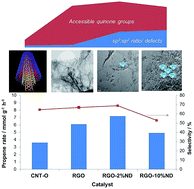Self-assembled graphene aerogel and nanodiamond hybrids as high performance catalysts in oxidative propane dehydrogenation†
Abstract
Graphene aerogels and graphene aerogel–nanodiamond hybrids have been fabricated by a mild reduction/self-assembly hydrothermal method using graphene oxide dispersion as a precursor. The aerogels have been used as metal-free catalysts for oxidative dehydrogenation of propane. Reduced graphene oxide (RGO) aerogels without nanodiamonds outperformed carbon nanotubes in terms of propene productivity and selectivity, which is correlated with a higher content of accessible carbonyl–quinone groups and more defective structures of reduced graphene oxide. Graphene aerogels loaded with low amounts of nanodiamonds (2 wt%) by a one-pot strategy provided 18% higher activity than RGO aerogels, ascribed to the increase of the sp3/sp2 ratio. For nanodiamond contents higher than 2 wt%, the productivity and selectivity drops, which can be explained by a dramatic decrease of carbonyl–quinone groups, an increased content of unselective oxygen species and clustering of nanodiamonds for the highest loadings. Hybrid aerogels are freestanding, robust and highly porous monoliths; thereby a suitable platform to be used as catalysts or adsorbents in flow systems.


 Please wait while we load your content...
Please wait while we load your content...